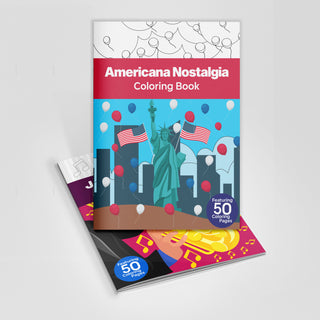50 Mystical Snakes Printable Coloring Pages For Kids & Adults (INSTANT DOWNLOAD)
- Unit price
- / per
Snakes have long been the victims of negative advertising. They have gotten a bad rap over literally thousands of years.
Why is this and where does this reputation come from?
Many of us associate snakes with evil. This comes out of Christian tradition where the snake was the foul creature who tempted Eve to eat the apple in the Garden of Eden.
This fatal move by Eve set humankind up to receive a legacy of pain and suffering, all because of the evil serpent.
The snake in the Bible represents the devil, and it has been hard for the snake to shake off that persona ever since.
There are some other reasons people don’t exactly care for snakes. First of all, their appearance doesn’t exactly say ‘warm and cuddly.’
Unlike a fluffy little kitten, or bunny rabbit, the snake has a smooth skin that looks like it would be slimy.
In actual fact, a snake is not slimy, but that's still not enough to make it endearing to many.
Snakes are long and thin and that’s opposite to what we are programmed to think of as good-natured and approachable.
Think of the stereotypical witch. She has a long, thin face and a narrow, pointy chin. The witch in The Wizard of Oz is a perfect example, and she has been giving kids nightmares for decades.
Another factor the snake doesn’t have going for it is the way it moves. It slithers.
It’s sneaky and surreptitious (a fancy word for sneaky;) and because of that we often don’t notice it until it is very nearby.
You know the scene, you’re walking along a path or in your backyard, when suddenly a quick, slithering motion grabs your attention. You almost step on the thing and shriek as your heart races.
So snakes seem shifty and sneaky to us, and therefore we don’t like them. The surprise attack is not a loveable trait.
Our fear of snakes is partly due to our ancestors. Back in the age of hunters and gatherers, the men of a tribe would go out hunting.
They needed to be on the lookout for poisonous snakes that might be in the long grass or drop out of a tree. A bite from one of these creatures could mean death.
This need to beware of snakes is built into us as a survival mechanism. Even though we have supermarkets to buy our groceries in, we still have that fear of snakes.
Despite all the negative stuff, snakes have a lot of cool aspects, too. Did you know that snakes have no eyelids? So they sleep with their eyes open.
There are more than 3,700 snake species in the world! That makes them the second largest reptile group, coming in just behind lizards.
Snakes can be found on every continent of the earth except Antarctica, and snakes can live in pretty much any and all conditions from deserts to mountains, oceans to forests.
Most snakes reproduce by laying eggs. Snakes have nostrils like we do, but unlike us, they don’t use them to smell. Have you ever noticed how a snake flicks its forked tongue in and out? It’s smelling!
If you take the time to look at a snake you will notice that it has a particular pattern on its body. Snakes come in all sorts of colors with beautiful, intricate designs.
Our relationship with snakes is complex and with so much history and negative associations, it can be challenging to see the beauty and amazing qualities a snake possesses, but it’s worth taking time to try.
In our “Mystical Snakes Coloring Book” you will find fifty pages of entrancing snakes from cobras and pythons to anacondas and vipers.
While you’re coloring these marvelous creatures, you’ll also be experiencing any number of fabulous benefits from this activity!
Read on to learn more about the many benefits of coloring!
Coloring has numerous benefits for both children and adults.
Pick up your coloring tool of choice and start experiencing mental, emotional and even physical benefits of this fun and accessible activity!
- Coloring promotes relaxation by engaging our mind in a meditative and calming activity, reducing stress and anxiety levels. Let the act of shading in these marvelous creatures ease the stress and strain of the day.
- Coloring increases focus and concentration, allowing us to immerse ourselves in the creative process and temporarily escape from daily pressures. The intricate designs of these snakes will encourage you to focus on the act of coloring.
- Coloring stimulates creativity, encouraging us to explore and experiment with various color combinations and patterns. Be an artist as you color these incredible snake sketches without feeling any pressure to do it in a certain way.
- Coloring can be a valuable tool for expressing ourselves, allowing us to convey emotions and feelings through art. In the peace and comfort of your chosen setting, you can create illustrations that reflect you and your feelings.
- Coloring can be a social activity, fostering bonding and communication when done in groups. Invite your friends who share your passion for snakes and have a coloring party!
Our coloring pages print with smooth lines at popular paper sizes, including Letter (8.5 inches x 11 inches) and A4 (210mm x 297mm).
You do not need an expensive printer or to have pages printed commercially. Our pages look great with both ink jet and laser printers.
50 Mystical Snakes Printable Coloring Pages For Kids & Adults (INSTANT DOWNLOAD)
- Unit price
- / per
Color your favorite pages over and over again. Print the whole book (including the cover) or individual pages.
Your coloring books are available the moment you complete your purchase and you never have to wait for shipping.
Adding product to your cart
You may also like
Snakes have long been the victims of negative advertising. They have gotten a bad rap over literally thousands of years.
Why is this and where does this reputation come from?
Many of us associate snakes with evil. This comes out of Christian tradition where the snake was the foul creature who tempted Eve to eat the apple in the Garden of Eden.
This fatal move by Eve set humankind up to receive a legacy of pain and suffering, all because of the evil serpent.
The snake in the Bible represents the devil, and it has been hard for the snake to shake off that persona ever since.
There are some other reasons people don’t exactly care for snakes. First of all, their appearance doesn’t exactly say ‘warm and cuddly.’
Unlike a fluffy little kitten, or bunny rabbit, the snake has a smooth skin that looks like it would be slimy.
In actual fact, a snake is not slimy, but that's still not enough to make it endearing to many.
Snakes are long and thin and that’s opposite to what we are programmed to think of as good-natured and approachable.
Think of the stereotypical witch. She has a long, thin face and a narrow, pointy chin. The witch in The Wizard of Oz is a perfect example, and she has been giving kids nightmares for decades.
Another factor the snake doesn’t have going for it is the way it moves. It slithers.
It’s sneaky and surreptitious (a fancy word for sneaky;) and because of that we often don’t notice it until it is very nearby.
You know the scene, you’re walking along a path or in your backyard, when suddenly a quick, slithering motion grabs your attention. You almost step on the thing and shriek as your heart races.
So snakes seem shifty and sneaky to us, and therefore we don’t like them. The surprise attack is not a loveable trait.
Our fear of snakes is partly due to our ancestors. Back in the age of hunters and gatherers, the men of a tribe would go out hunting.
They needed to be on the lookout for poisonous snakes that might be in the long grass or drop out of a tree. A bite from one of these creatures could mean death.
This need to beware of snakes is built into us as a survival mechanism. Even though we have supermarkets to buy our groceries in, we still have that fear of snakes.
Despite all the negative stuff, snakes have a lot of cool aspects, too. Did you know that snakes have no eyelids? So they sleep with their eyes open.
There are more than 3,700 snake species in the world! That makes them the second largest reptile group, coming in just behind lizards.
Snakes can be found on every continent of the earth except Antarctica, and snakes can live in pretty much any and all conditions from deserts to mountains, oceans to forests.
Most snakes reproduce by laying eggs. Snakes have nostrils like we do, but unlike us, they don’t use them to smell. Have you ever noticed how a snake flicks its forked tongue in and out? It’s smelling!
If you take the time to look at a snake you will notice that it has a particular pattern on its body. Snakes come in all sorts of colors with beautiful, intricate designs.
Our relationship with snakes is complex and with so much history and negative associations, it can be challenging to see the beauty and amazing qualities a snake possesses, but it’s worth taking time to try.
In our “Mystical Snakes Coloring Book” you will find fifty pages of entrancing snakes from cobras and pythons to anacondas and vipers.
While you’re coloring these marvelous creatures, you’ll also be experiencing any number of fabulous benefits from this activity!
Read on to learn more about the many benefits of coloring!
Coloring has numerous benefits for both children and adults.
Pick up your coloring tool of choice and start experiencing mental, emotional and even physical benefits of this fun and accessible activity!
- Coloring promotes relaxation by engaging our mind in a meditative and calming activity, reducing stress and anxiety levels. Let the act of shading in these marvelous creatures ease the stress and strain of the day.
- Coloring increases focus and concentration, allowing us to immerse ourselves in the creative process and temporarily escape from daily pressures. The intricate designs of these snakes will encourage you to focus on the act of coloring.
- Coloring stimulates creativity, encouraging us to explore and experiment with various color combinations and patterns. Be an artist as you color these incredible snake sketches without feeling any pressure to do it in a certain way.
- Coloring can be a valuable tool for expressing ourselves, allowing us to convey emotions and feelings through art. In the peace and comfort of your chosen setting, you can create illustrations that reflect you and your feelings.
- Coloring can be a social activity, fostering bonding and communication when done in groups. Invite your friends who share your passion for snakes and have a coloring party!
Our coloring pages print with smooth lines at popular paper sizes, including Letter (8.5 inches x 11 inches) and A4 (210mm x 297mm).
You do not need an expensive printer or to have pages printed commercially. Our pages look great with both ink jet and laser printers.
You may also like
You may also like

By completing this form, you are signing up to receive our emails and can unsubscribe at any time.




















